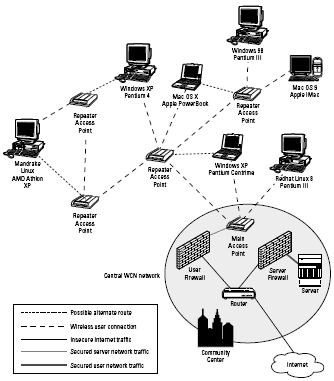A number of towns have created public wireless networks with wide geographical coverage. These mostly use the extended network model, or create large hotspots. The Center for Neighborhood Technology in the Chicago area illustrates the use of what is called a mesh network.
CNT has implemented wireless networks for the communities of Pilsen and Lawndale in Chicago, the suburban community of Elgin that is 40 miles northwest of Chicago, and in West Frankfurt, which is in southern Illinois.
Similar projects have been done in the Seattle area by SeattleWireless and in rural settings. The projects are meant to encourage business and cultural development in these areas, creating a community asset that different organizations can leverage.
CNT uses community partners, schools, community centers and other organizations to develop this network. What’s particularly interesting about the CNT projects is that they use what CNT calls a “mesh” technology in place of a hub and spoke topology.
In a home network you would connect all of your wireless devices to a single access point connection to the Internet and rely on connections to additional remote access points for the network’s fan out.
By contrast, the mesh model has a central access point, but instead of managing wireless links to additional access points (with all the complexity that that entails), this mesh network uses a set of repeaters to enlarge the coverage area of the WLAN.
In either case you could fortify the access point that provides the connection to your Internet backbone in a number of ways, but managing a set of repeaters provides some fault tolerance because the areas of coverage can be made to overlap.
If a repeater fails, only the area it covers is lost and other areas contiguous with that area will find other paths back to the main access point. Figure 1 shows you the topology of the mesh network that CNT offers.
Notice in particular that the main access point is placed in front of two firewalls, one for servers and the other for users. This protects the network’s essential core services on servers from intrusion and has one firewall authenticate the users for network management—which are the two most important features of a secure network neighborhood.
What we particularly like about this mesh network is that the reliance on repeaters to spread the signal not only simplifies network management and settings, but it also allows the network to grow and scale as the number of users grows.
Not only do repeaters provide you with the necessary geographical coverage, but additional routers can be put in the same coverage area to provide both fault tolerance and greater bandwidth.
This topology is similar in design to a cell phone network where a signal is repeated from one transmitter to another until the message is received on a node directly connected to the network.
